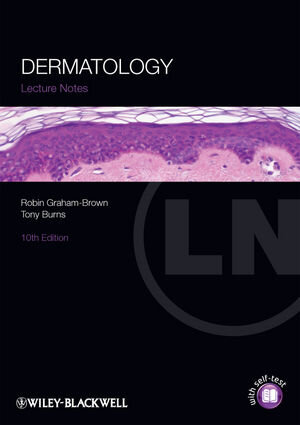
I am a big fan of the Lecture Notes series, having usedmany of the titles throughout medical school. This update to theDermatology volume is much improved and easier to read. Itsphysically bigger than I remember, with well-spaced, clear, colourful pictures. The clinical photographs are very good. Thereare numerous histology photos/diagrams - these aren'toften done very well in student texts and are very important inunderstanding the subject (similar to radiographs in surgery). Thesummary boxes are clear and easy to spot, and provide all thesalient points likely to be asked in clinic or on ward round.
Special mention to:
-The glossary of dermatological terms, extremely useful.
-The case studies and MCQs, which cover the range of topics in thebook
-Nearly every major dermatological condition has a paragraphsection, including the rarer inherited conditions.
Compared to its competitors (eg Gawkrodger), this book has thebetter balance of pretty pictures, and useful academic prose. Is agood substitute for clinical experience, in those medical schoolswhere Dermatology practice is limited. (Junior Doctor)
Among the myriad of basic dermatology textbooks available for thoseseeking an introduction into the world of dermatology, LectureNotes has always held its place as a popular choice. This successis largely down to the authors' accomplishment in covering awide range of topics in a concise and digestible format. At aglance, the 10th edition seems to have done enough to maintain itsplace as one of the students' favourites.
The traditional white facade has been replaced by a new sleekblack cover in this 10th update. There are a total of 23 clearlylaid out chapters with well-structured content and a helpfulglossary and self-assessment questions towards the back. New tothis edition is a useful additional chapter on dermatologicalemergencies, aiming to better equip newly qualified doctorsencountering such daunting challenges. The absence of images andconcepts of management of skin failure in this chapter is a notableomission.
The opening chapter begins with the basic biology of skin, hairand nails, without too much complex pathophysiology and then movesswiftly on to the approach to diagnosing dermatological diseases. Subsequent chapters cover the core dermatological disorders; eczema, psoriasis and skin tumours are explained in a concise, logical way without going into unnecessary levels of detail. Thediagrams that accompany each chapter are extremely clear and helpthe reader to understand the underlying pathogenesis.
Each chapter has a clear narrative and is generally wellcomplemented with high-quality illustrations, which are essentialin a specialty where 'a picture is worth a thousandwords'. However, certain sections, such as eczema management, would benefit from further visual aids, highlighted boxes andclearer treatment plans. Compared with other introductorydermatology texts, one might find this publication somewhat'wordier'.
Overall, this is a very well written introductory dermatologytext with excellent clinical photographs and diagrams. We wouldhighly recommend this for those wishing to grasp the basic conceptsin dermatology. (Minh Lam & Rabi Nambi, Dermatology Department, Royal Derby Hospital)
Presented in a user-friendly format, combining readability withhigh quality illustrations, this tenth edition has been revised toreflect recent advances in knowledge of skin diseases anddevelopments in therapy, and features a brand new chapter onDermatological Emergencies.
Key features include:
* Numerous figures and tables help distil the information youneed for revision purposes
* MCQs and 15 new clinical case studies for self assessment
* Glossary of dermatological terms
Whether you need to develop or refresh your knowledge ofdermatology, Lecture Notes: Dermatology presents 'need toknow' information for all those involved in treating skindisorders.



